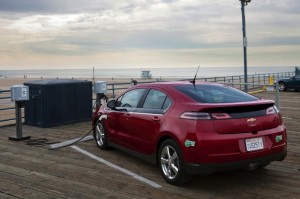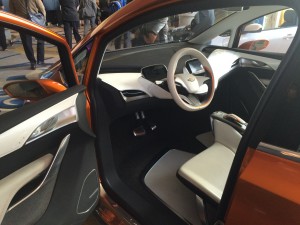Forget auto shows, as the International Consumer Electronics Show in Las Vegas seems to be getting all the snazzy new vehicles, particularly the electric ones. General Motors picked the occasion to announce finally the 200-mile range, $30K “Bolt”:
[Ms.] Barra said on Wednesday that G.M. is “committed to electrification” despite the lagging sales of current electric cars and hybrids. Others at G.M. said the new Bolt could change consumers’ perception of purely electric cars as strictly for commuting and other short trips.
“All of our research shows the buyer consideration goes up dramatically with a range of over 150 miles,” said Pam Fletcher, G.M.’s chief engineer for electric vehicles.
GM is also partnering with Lyft for an all-electric rideshare service, which one day may include driverless vehicles. Not to mention that secretive Faraday Futures automaker unveiled its concept race car to the masses.
It’s a fascinating convergence of software and battery technology that we’re living through, and it will change our transportation landscape dramatically in the coming decade.
 Among electric vehicle aficionados, the Chevy Volt is sort of a black sheep of the bunch. The car was one of the original “Big 3” of the electric vehicle market, along with the Nissan LEAF and Tesla Model S. But unlike those two cars, which represented opposite ends of the price and range spectrum for an all-battery vehicle, the Chevy Volt tried to be an all-in-one consumer car. For about $34,000 (without incentives), it features a 38-mile all-electric battery range. And then a gas engine kicks in to give you the full range of an internal combustion engine car.
Among electric vehicle aficionados, the Chevy Volt is sort of a black sheep of the bunch. The car was one of the original “Big 3” of the electric vehicle market, along with the Nissan LEAF and Tesla Model S. But unlike those two cars, which represented opposite ends of the price and range spectrum for an all-battery vehicle, the Chevy Volt tried to be an all-in-one consumer car. For about $34,000 (without incentives), it features a 38-mile all-electric battery range. And then a gas engine kicks in to give you the full range of an internal combustion engine car.
But the Volt has some obvious limitations. First is the 38-mile battery range. After that, the gas engine requires more expensive premium gas. And some customers complained about the lack of room in the back seat, with two adults fitting uncomfortably (whereas I can fit two carseats and a booster in the backseat of my LEAF). Perhaps as a result, sales have fallen in the last two years, as Inside EVs reports:
For full year 2014, 18,805cars were been sold – which is down 18.6% from 2013 when GM moved 20,702 Volts. This means that the Volt is the first electric vehicle to post two consecutive years of falling sales in America.
Some analysts believe the drop-off was in part due to customer awareness that Chevy was about to introduce a new version of the Volt this year. And that just happened:
The big news — other than the sleeker, all-new design — is that electric-only range has increased about a dozen miles to 50. At that point, a gas engine kicks in, offering a total range of “more than” 400 miles before a fill-up and recharge are necessary. The engine is all-new, a 1.5-liter unit that takes regular gas and delivers a combined fuel economy of 41 mpg when in use. Charging comes in 4.5 hours connected to a 240-volt source.
Yet if I had to guess, I think the Volt’s electric/gas combo presents a fundamental consumer challenge that will be hard to overcome. And it’s a problem for virtually any plug-in electric that also has a gas engine. In my view, with the electric/gas combo, you get the worst of both worlds without inspiring passion among any consumer group. The battery range isn’t enough to get drivers gas-free, a major shortcoming if you’re motivated by either environmental concerns or a desire for the superior driving experience of going electric. And the gas part of the car is expensive (premium fuel) and negates the low-maintenance advantage of an all-electric: you still need the extra thousand moving parts for an internal combustion engine, with all the sparkplugs and oil changes and transmissions to worry about.
I think most drivers want either all-electric or nothing. The extra range with a gas engine isn’t that necessary for most trips. An 85-mile range in a cheap all-battery car covers 95% of trips. You’re almost better off renting a cheap car for those few long-distance trips a year, rather than sticking a gas engine in your battery EV. The Volt is certainly a good car for those who only want one all-purpose car and really need the extra range from the gas engine — basically long-distance commuters. But I don’t think this plug-in/gas model is really viable in the long run, particularly as batteries improve in price and performance.
Perhaps that’s why Chevy is now working on the “Bolt” — an all-electric, $30,000, 200 mile range EV to compete with Tesla’s hyped up Model 3, due supposedly in 2017. It’s great to see the automakers competing for this coveted breakthrough in EV technology. And once the Bolt is out, I will definitely consider a Chevy EV. But not so much with the Volt.



